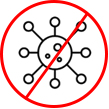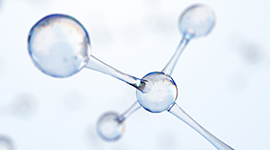Company Introduction
Business areas
Technology
Products
Customer Support
TECHNOLOGY
- HOME
 Technology
Technology Raw materials
Raw materials
Raw materials

We should now use chlorine dioxide, which is beneficial to the environment and harmless to the human body.

Chlorine dioxide has the advantage of being harmless to the human body and beneficial to the environment. With this advantage, it is rapidly taking over the market for sterilization and disinfection, which has been dominated by chlorine-based (LAX) products.

Chlorine dioxide overview
Chlorine dioxide is a material recognized by the World Health Organization to have the highest safety level, and it is safe and effective.

Sterilization and deodorization

Harmless to human body

Environmentally friendly
[Sterilizing effect of chlorine dioxide]
| Species | Extinction time |
|---|---|
| Coliform bacillus | Less than 10 seconds (99.99%) |
| Staphylococcus aureus | Less than 10 seconds (99.99%) |
| Salmonella | Less than 10 seconds (99.99%) |
| Bacillus bacteria | Less than 10 seconds (99.99%) |
| Pneumobacillus | Less than 10 seconds (99.99%) |
| Shigella dysenteriae | Less than 10 seconds (99.99%) |
| Shigella | Less than 10 seconds (99.99%) |
| Pseudomonas aeruginosa | Less than 10 seconds (99.99%) |
| Pathogenic coliform bacillus | Less than 10 seconds (99.99%) |
| Typhoid fever | Less than 10 seconds (99.99%) |
| Norovirus | Less than 10 seconds (99.99%) |
| Swine flu | Sterilization (99.99%) |
| AI Bird Flu | Sterilization (99.99%) |
| Super bacteria | Sterilization (99.99%) |

[Chlorine dioxide VS chlorine (LAX) sterilizer]
| Classification | Aqueous chlorine dioxide | Chlorine disinfectants (HCIO, NaCIO, NaCIO2) |
|---|---|---|
| Classification | Oxygen system | Chlorine (Oxygen) |
| Active ingredient | Oxygen (O2) | duath(CI+O) |
| Sterilization power | 2.5 times or more | 1 |
| Disinfecting power | 5 times or more | 1 |
| Sterilization effect | Most fungi, bacteria and viruses | Some fungi, bacteria and viruses |
| Sterilization pH range | 2~10 | 2-7 (Strong acidity) |
| Permeability | Cell wall and internal structure penetration | Impervious |
| safety | Safe | Danger of contact with skin, airways and eyes |
| Metal corrosion resistance | None | Metal corrosion |
| Fiber bleaching effect | Exists | Fiber discoloration and bleaching |
| Convenience | Can be used up to closed spaces | Inappropriate for spraying, ventilation required |
| Active odor | Weak, volatilized in a short time | Strongly irritating chlorine odor (residual) |
| Disinfection persistence | Maintained | Bacteria regrowth, virus residue |
| Selectivity | Does not react with organic matter | Reacts with organics to produce by-products |
| Disinfection by-products | None | Carcinogen (Trehalomethane, etc.) |
| Protozoa | Removed (Main component decomposition of protein composition) | Partially removed |
| Heavy metal removal function | Removal of iron, manganese, phenol, etc. | Impossible |

Status of usage
It has been used for a long time in developed countries such as the United States and Europe, in a wide range of fields.

In 2006, the U.S. Environmental Protection Agency (EPA) established guidelines for specific uses and applications ranging from drinking water to agricultural, commercial and industrial facilities, swimming pools, and residential facilities.
In Korea, it was approved for use as a sterilizing disinfectant under the Drinking Water Control Act of 1999 (since chlorine dioxide is a water-soluble oxidizing agent, it does not generate carcinogens due to by-products, and has environmentally friendly properties that are easily decomposed by light which make it safe to be used as drinking water).
In Korea, it was approved for use as a sterilizing disinfectant under the Drinking Water Control Act of 1999 (since chlorine dioxide is a water-soluble oxidizing agent, it does not generate carcinogens due to by-products, and has environmentally friendly properties that are easily decomposed by light which make it safe to be used as drinking water).
[Status of domestic chlorine dioxide approval]
| Approval year | Approval organization and contents |
|---|---|
| 1999 | Ministry of Environment Notice No. 1999-173, chlorine dioxide in drinking water is recognized as a disinfectant (1 ppm or less) |
| 2000 | The Ministry of Environment evaluated that disinfection of chlorine dioxide was the most economical in the guidelines for the installation of a sewage treatment plant disinfection facility |
| 2007 | Food and Drug Administration Notification No. 2005-33, designated to use chlorine dioxide as a disinfectant for furniture (200 ppm or less) |
| 2006 | Food and Drug Administration Notification No. 2007-74, permits the use of chlorine dioxide water for sterilization of fruits and vegetables and food in the standards and specifications of food additives |
| 2008 | Agriculture, Forestry and Fisheries, Food Industry Promotion Act No. 9759, designation and use of chlorine dioxide as a processing aid for organic products |
| 2009 | Ministry of Food and Drug Safety Announcement No. 2009-66, in order to ensure the safety of marine products, substances for hygiene management in Sashimi Aquarium are limited to food ingredients, chlorine dioxide and silicon dioxide. |
[Each country's chlorine dioxide certification]
| Organization | Contents |
|---|---|
| Food and Drug Administration (US) | Registered as a food additive in 1998 |
| Environmental Protection Agency(US) | 1967 US EPA, registered chlorine dioxide water as a sterilizing disinfectant |
| 1967 US EPA, registered to use chlorine dioxide as a food additive | |
| 1968 US EPA, registered chlorine dioxide as a sterilizing disinfectant | |
| 2006, determined the suitability for use and stipulating the detailed use and method of use | |
| European Union | 1968, declared to member countries that it can be used as a disinfectant for drinking water. |







